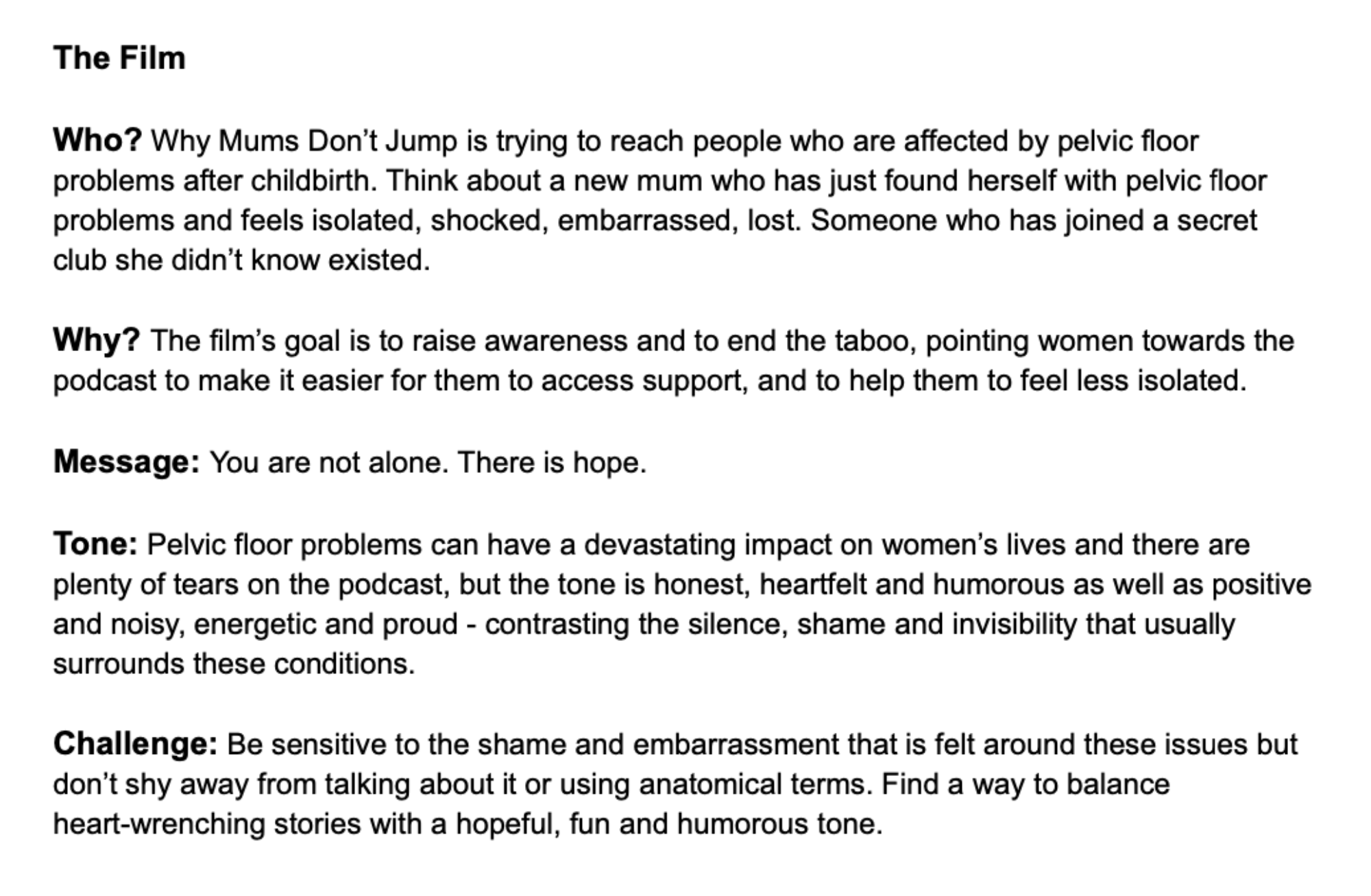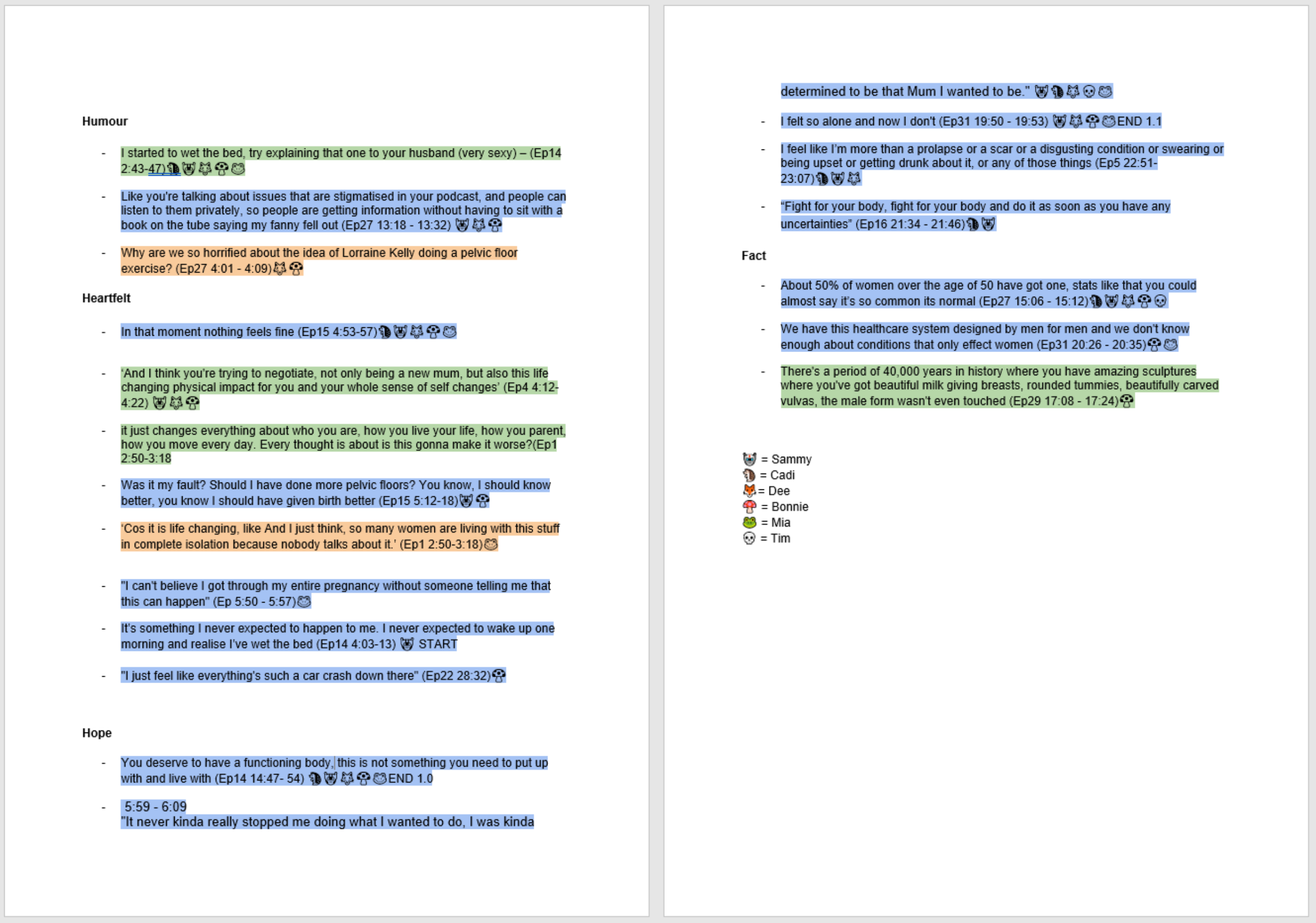WMDJ - research
“There are very hard hitting moments in that podcast, it’s very kind of emotionally charged moments because it’s very personal issue...we also wanted it to be quite hopeful.”
Bonnie Harris We really wanted to use the podcast clips because what an amazing resource to be able to have access to.
Sammy Reavley Also I think our main kind of thing that we wanted to, which was part of the client brief, that we really wanted to tap into was the aspect of the audience not feeling alone, or people who are going through it not feeling alone. So we literally, were just in a meeting, we were like, well, if we got the voice clips, then we might as well just use them and combine different people talking to really emphasise that idea of community of say, hey here's everyone else dealing with it. And because of that, you shouldn't have to feel alone or like that embarrassed about it.
Client brief
Bonnie Harris We had such a diverse range of people talking about it anyway, why wouldn't we use that diverse range? Actual people's experiences and not... because we did to get to a point. Yeah, at one point, we were thinking, should we rerecord the lines? Because some of the audio was kind of a bit I know there might have been like music underneath it and stuff like that. But it was like, no, we really want to use the original audio because it just doesn't feel like it would be as authentic if we didn't, which is why we ended up using the original podcast audio, because it's like authentic stories told by real women about their real issues.
Rosa Mulraney It comes across that kind of the trials and tribulations and the kind of passion through it, the kind of emotional core to it comes across. So that does make sense. And also kind of sometimes, you know the audio or the visuals are good enough. You know, they're not perfect, but they're good enough. Yeah, you guys did really well. So how on earth did you pick out the clips from 3 series of podcasts?
Bonnie Harris So we actually delegated, I think it was about five each? It ended up being about five podcasts each, podcast episodes each, to each person. And we all went away over the weekend and listened to five episodes of the podcast. And then whilst listening to it jotted down timestamps of quotes that we thought were really useful. And then in a meeting, we basically shared all of those timestamps and be like, this is what's said. And then it took us quite a while to like, like, we had the first draft of "Okay, this is what we need. How long is it?” “It's five minutes.” “Okay. Which ones do we want to get rid of? Oh, but these are also good." Yeah. And yeah, it took about a week of us just be like, “No, we have to get rid of this clip.” “I know, it's really good.” “But we have to get rid of this audio clip and just doesn't, you know, this one basically says it there.” And yeah, we listen to every single podcast episode, basically. Yeah.
Researching the podcast transcripts
Rosa Mulraney So really good research. So you dived in deep, you know, which John Stevenson has talked about in the past, you know, when you worked on Kung Fu Panda, he said, he just dived into the research of trying to learn everything about China. So before he started the creative process, he could kind of make informed decisions and that keeps coming up a lot in short film making. That research is really important. So you know, you guys dived in. You did the research, and you had a process, a sort of strategy to tackle that workload. And then by process of elimination, you're kind of picking out the quotes that resonated the most, I guess, and kind of made a, you try to make a cohesive story from it as well.
Sammy Reavley Yeah, I think, yeah, cuz we kind of talked about like the direction that we wanted to go for we, we really focused on the bit where she said that she didn't want it to be completely kind of downtrodden, incredibly kind of like bleak, because there are very hard hitting moments in that podcast, it's very kind of emotionally charged moments because it's very personal issue. So we didn't want to go down the route of just having like, the really emotional clips, we also wanted to be quite hopeful. So I think the route that we kind of went with was... Originally it was going to be very kind of like, kind of funny introduction, and then emotional and then hopeful. But I think that kind of changed as you went along. I think it became more kind of like emotional, to then funny and then hopeful.
Bonnie Harris Yeah, so we told a story, but it was an emotional story and not a narrative story.



